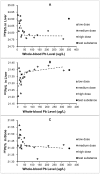Variations in lead isotopic abundances in Sprague-Dawley rat tissues: possible reason of formation
- PMID: 24587048
- PMCID: PMC3934954
- DOI: 10.1371/journal.pone.0089805
Variations in lead isotopic abundances in Sprague-Dawley rat tissues: possible reason of formation
Abstract
It has been reported in previous research that the lead isotopic composition of blood, urine and feces samples statistically differed from the given lead sources in Sprague-Dawley (SD) rats. However, the reason for this phenomenon is still unclear. An animal experiment was performed to investigate the lead isotope fractionation in diverse biological samples (i.e., lungs, liver, kidneys, bone) and to explore the possible reasons. SD rats were intratracheally instilled with lead acetate at the concentrations of 0, 0.02, 0.2, and 2 mg/kg body weight. Biological samples were collected for lead isotope analysis using an inductively coupled plasma mass spectrometry (ICP-MS). Significant differences are observed in lead isotope abundances among the diverse biological samples. The lead isotope abundances ((206)Pb, (207)Pb and (208)Pb) in diverse biological samples show different degrees and directions of departure from the given lead source. The results suggest that differences in enrichment or depletion capacity for each lead isotope in the various tissues might lead to the variation in lead isotopic abundances in tissues. Moreover, a nonlinear relationship between the blood lead level and the lead isotope abundances in liver and bone is observed. When the whole-blood level is higher than 50 ng/mL, the lead isotopic compositions of biological samples tend to be the same. Thus, the data support the speculation of a fractionation functional threshold.
Conflict of interest statement
Figures




Similar articles
-
Concerns about Quadrupole ICP-MS Lead Isotopic Data and Interpretations in the Environment and Health Fields.Int J Environ Res Public Health. 2018 Apr 11;15(4):723. doi: 10.3390/ijerph15040723. Int J Environ Res Public Health. 2018. PMID: 29641487 Free PMC article. Review.
-
Biological fractionation of lead isotopes in Sprague-Dawley rats lead poisoned via the respiratory tract.PLoS One. 2012;7(12):e52462. doi: 10.1371/journal.pone.0052462. Epub 2012 Dec 26. PLoS One. 2012. PMID: 23300678 Free PMC article.
-
Influence of temporal variations in water chemistry on the Pb isotopic composition of rainbow trout (Oncorhynchus mykiss).Sci Total Environ. 2005 Nov 1;350(1-3):204-24. doi: 10.1016/j.scitotenv.2005.01.030. Sci Total Environ. 2005. PMID: 15885756
-
Disposition of lead (Pb) in saliva and blood of Sprague-Dawley rats following a single or repeated oral exposure to Pb-acetate.Toxicology. 2006 May 1;222(1-2):86-94. doi: 10.1016/j.tox.2006.01.030. Epub 2006 Feb 28. Toxicology. 2006. PMID: 16510233
-
Isotope ratio determination in boron analysis.Biol Trace Elem Res. 1998 Winter;66(1-3):39-53. doi: 10.1007/BF02783124. Biol Trace Elem Res. 1998. PMID: 10050906 Review.
Cited by
-
Evidence of isotopic fractionation of natural uranium in cultured human cells.Proc Natl Acad Sci U S A. 2016 Dec 6;113(49):14007-14012. doi: 10.1073/pnas.1610885113. Epub 2016 Nov 21. Proc Natl Acad Sci U S A. 2016. PMID: 27872304 Free PMC article.
-
Impact of uranium uptake on isotopic fractionation and endogenous element homeostasis in human neuron-like cells.Sci Rep. 2018 Nov 21;8(1):17163. doi: 10.1038/s41598-018-35413-4. Sci Rep. 2018. PMID: 30464301 Free PMC article.
-
Monitoring Lead (Pb) Pollution and Identifying Pb Pollution Sources in Japan Using Stable Pb Isotope Analysis with Kidneys of Wild Rats.Int J Environ Res Public Health. 2017 Jan 10;14(1):56. doi: 10.3390/ijerph14010056. Int J Environ Res Public Health. 2017. PMID: 28075384 Free PMC article.
-
Concerns about Quadrupole ICP-MS Lead Isotopic Data and Interpretations in the Environment and Health Fields.Int J Environ Res Public Health. 2018 Apr 11;15(4):723. doi: 10.3390/ijerph15040723. Int J Environ Res Public Health. 2018. PMID: 29641487 Free PMC article. Review.
References
-
- Lambertucci SA, Donázar JA, Huertas AD, Jiménez B, Sáez M, et al. (2011) Widening the problem of lead poisoning to a South-American top scavenger: Lead concentrations in feathers of wild Andean condors. Biological Conservation 144(5): 1464–1471.
-
- Meyer PA, Brown MJ, Falk H (2008) Global approach to reducing lead exposure and poisoning. Mutation Research/Reviews in Mutation Research 659(1): 166–175. - PubMed
-
- Komárek M, Ettler V, Chrastný V, Mihaljevič M (2008) Lead isotopes in environmental sciences: a review. Environment International 34(4): 562–577. - PubMed
-
- Bollhöfer A (2012) Stable lead isotope ratios and metals in freshwater mussels from a uranium mining environment in Australia’s wet-dry tropics. Applied Geochemistry 27(1): 171–185.
Publication types
MeSH terms
Substances
LinkOut - more resources
Full Text Sources
Other Literature Sources

